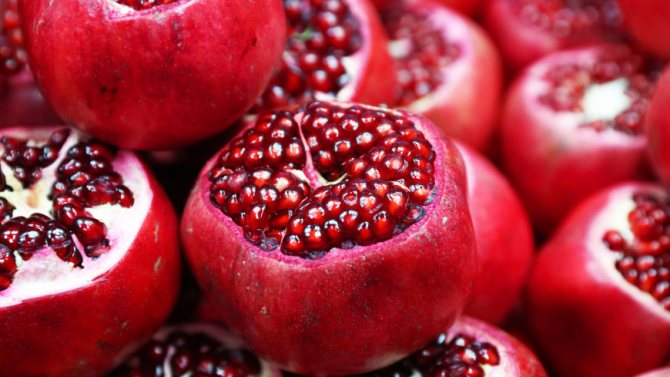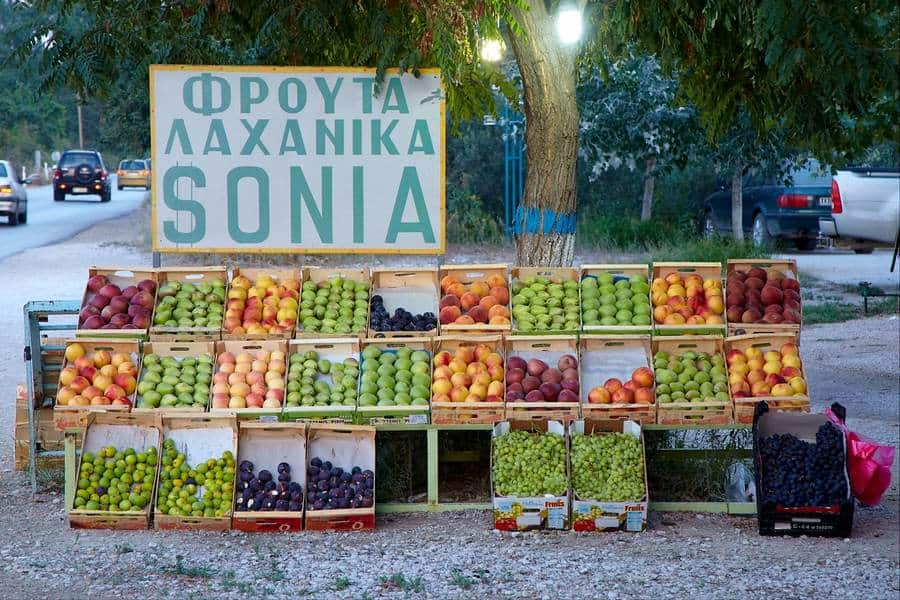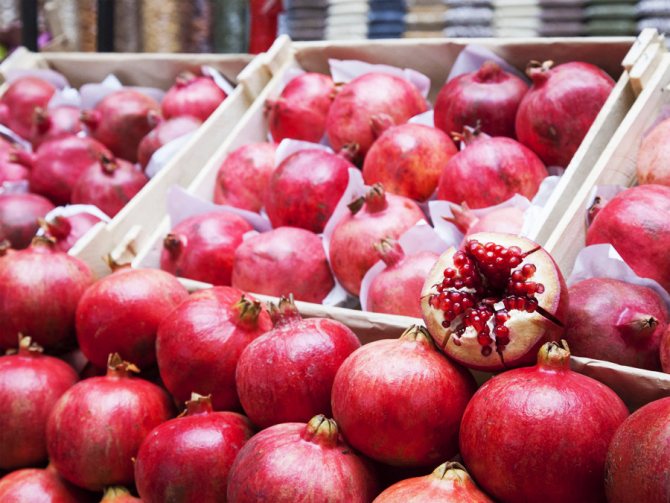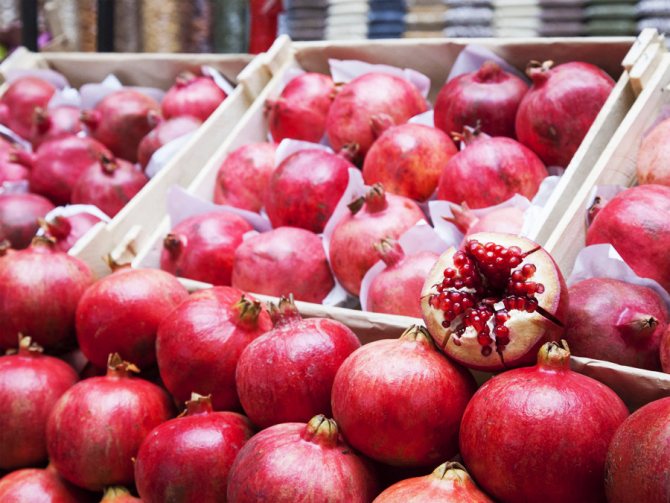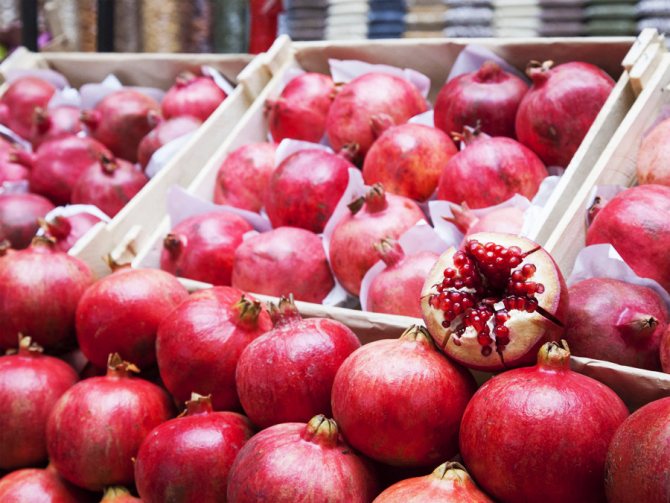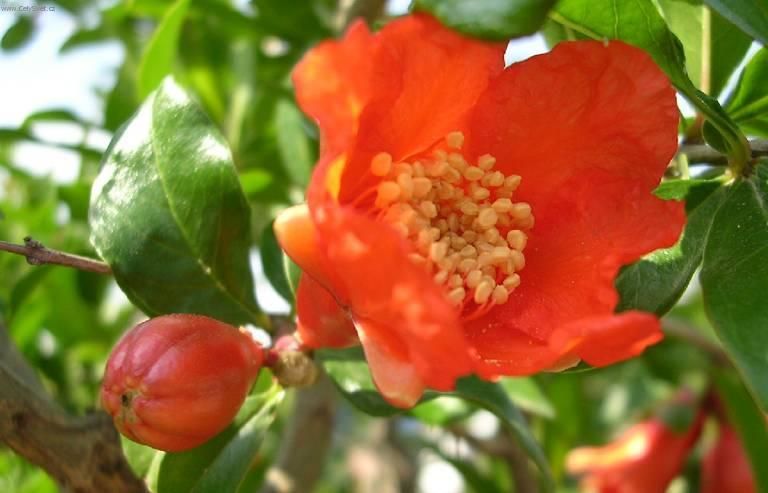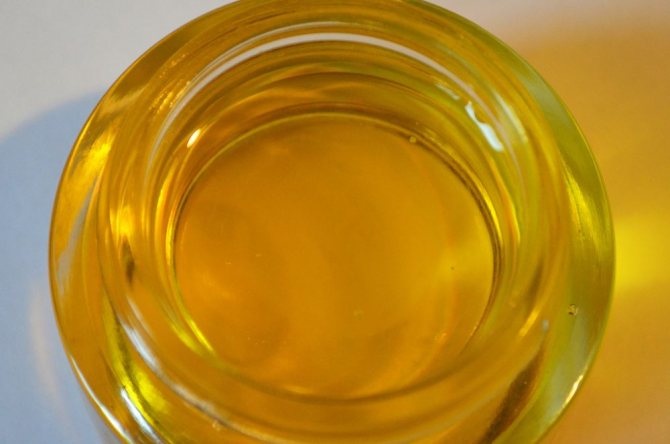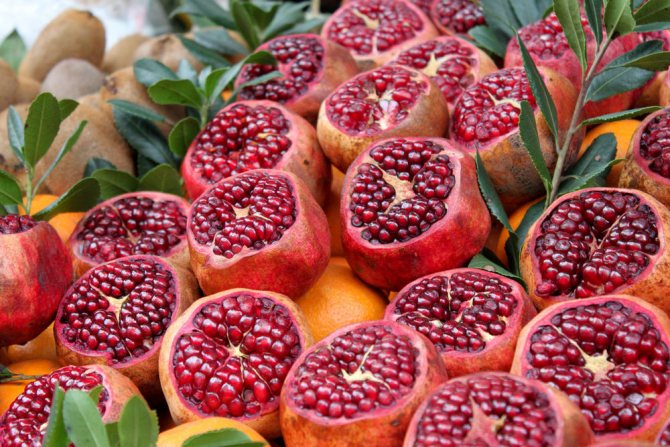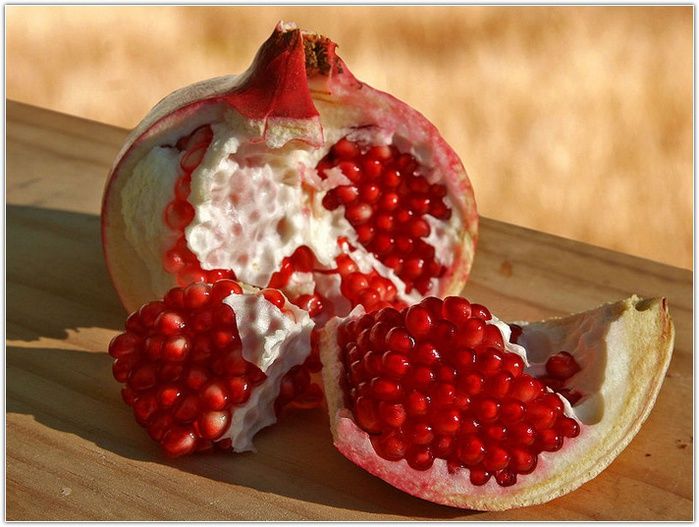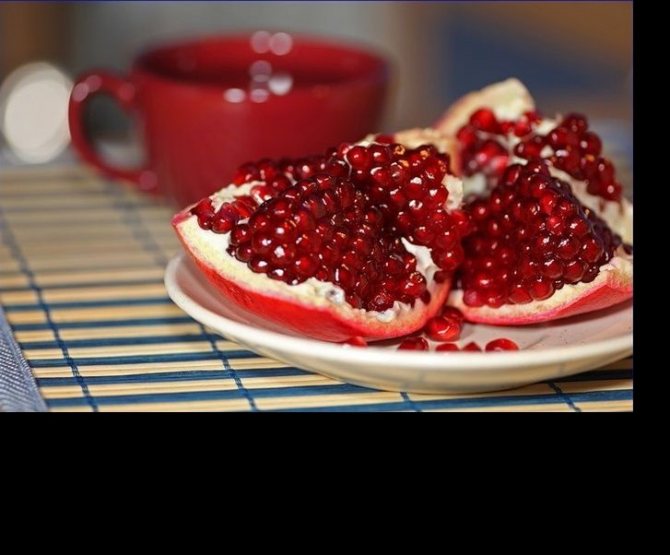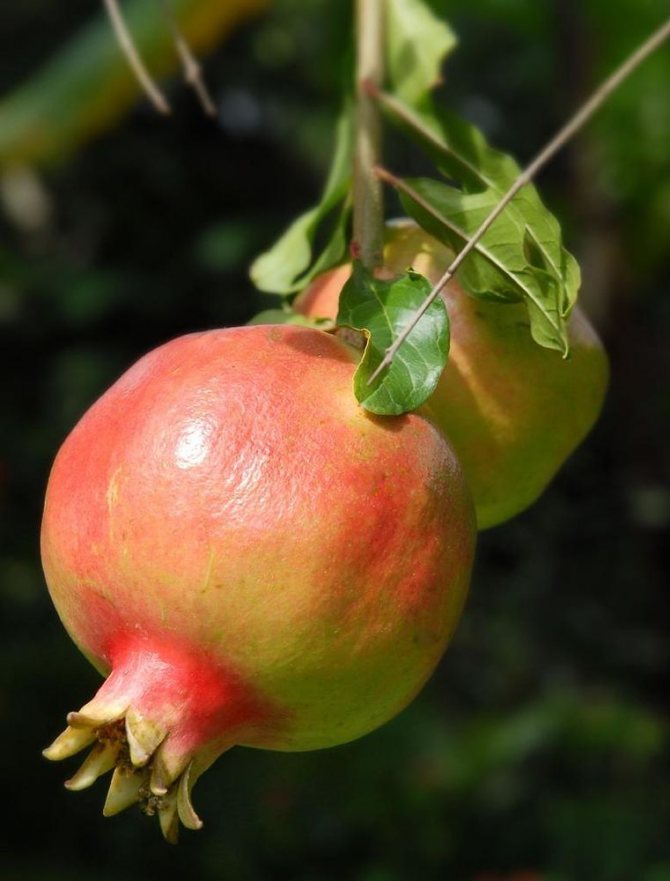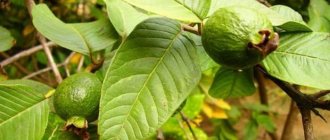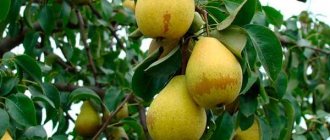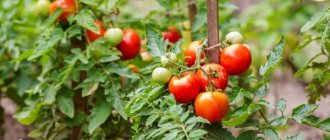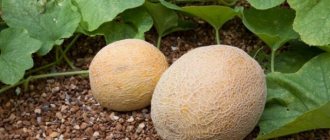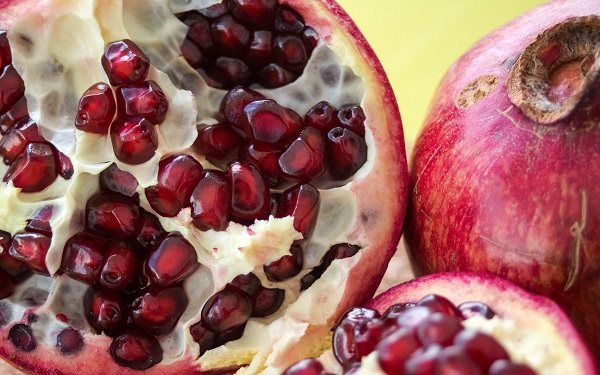
Pomegranate is sometimes called a royal product, its unique taste is a real decoration of both daily and holiday dishes. Often people ask the question: a pomegranate is a fruit or a berry, and here opinions differ. Some believe that this is a berry, others - that a fruit, whose opinion is true, you can find out the answer by reading this article.
How to choose a ripe pomegranate?
Pomegranate is a beautiful exotic fruit that is one of the most unusual and useful. Moreover, the cost of such a product cannot be called affordable. Therefore, it is especially important for the buyer to choose exactly the pomegranate that will definitely delight him with its ripe taste. But in order to choose a really good pomegranate in a store, without falling for the tricks of unscrupulous sellers, you need to have some experience and knowledge. In the same way as in order to peel such a fruit and get to the delicious scarlet grains.
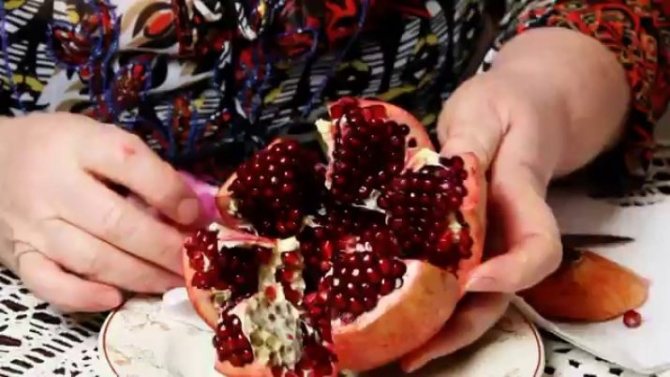

Pomegranate is indicated for diabetes
Unlike other, sweeter juices, pomegranate can be consumed for diabetes (in moderation). It is not harmful, but even useful. So, pomegranate juice has a diuretic effect, which helps to reduce edema, which is often found in diabetics in the early stages of the disease.
In addition, diabetes often leads to urological complications. To eliminate the discomfort with infections of the bladder, diluted pomegranate juice with honey is used.
However, people with impaired metabolism should not drink commercial pomegranate juice, as manufacturers often sweeten it. Safer and healthier is freshly squeezed juice diluted with water, or just grains.
Features of the fruit
Many people are used to thinking that pomegranate is a fruit, which is why both suppliers and buyers call it that. However, when you consider the botanical features of the pomegranate, it becomes obvious that this is a berry. The pomegranate grows on the branches of small trees and shrubs. It is a fruit of a rather large size, round in shape, with a characteristic unusual "tail". The inside of the fruit is not the pulp, like most fruits and berries, but small grains. On average, one pomegranate contains about 500 of them. They are separated by a thin light skin.
This fruit is one of the most ancient. The Arabian Peninsula is considered to be his homeland. But pomegranate also grows in many countries with tropical climates, and even in the subtropics. Specifically: in the Middle East, the Caucasus, Turkey, Spain, Greece, Italy, Portugal and the like. On the territory of Russia and neighboring countries, pomegranate trees can be found in the south of Dagestan, Azerbaijan and the Black Sea, for example, in Abkhazia.
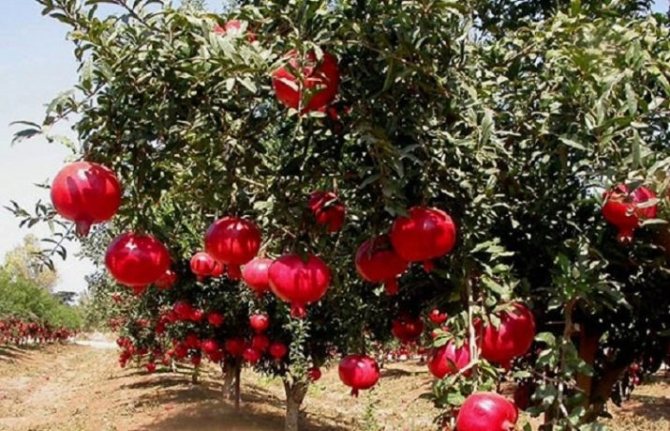

The benefits of pomegranate
Unusual fruits of the guarantor are a real storehouse of vitamins and useful microelements. Like many red fruits, pomegranate has a beneficial effect on the condition of people who suffer from diseases of the cardiovascular system (hypertension, anemia, and so on). But pomegranate also contains a large amount of fiber, organic acids, fructose and glucose. And also vitamins of group B, A, C, E, PP. In addition, pomegranate is an excellent antioxidant, in this indicator it surpasses apple, orange and pineapple juice, even green tea, and also helps to restore the balance of hormones in the body.
Regular consumption of ripe pomegranate seeds can help to cope with depression and improve mood. And also, according to nutritionists, pomegranate is a dietary product and helps to burn excess fat. This means that overweight people should especially take a closer look at such a delicacy.
In one fruit, after ripening, about 40% of all nutrients are formed that an adult needs to consume per day.
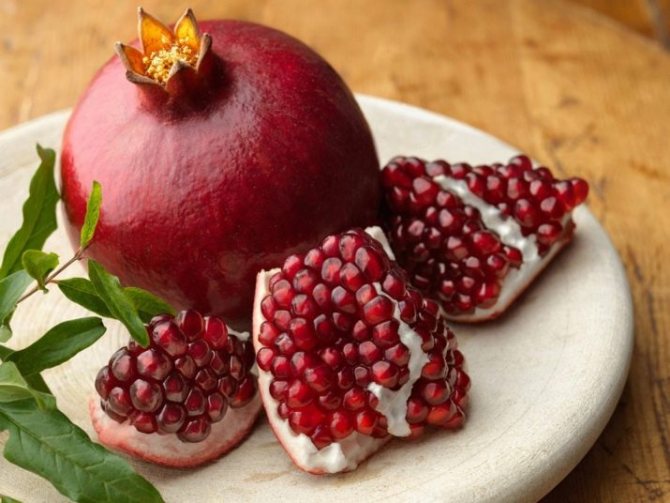

Botanical characteristic
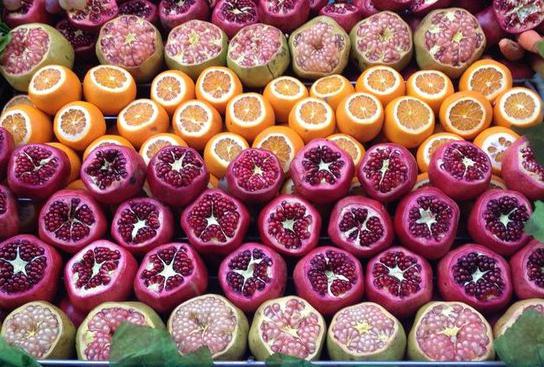

Adult pomegranate trees sometimes reach a height of up to five meters, and shrubs - no more than a meter. You can spot them by the oblong leaves of a bright green hue. Unripe fruits are small, but in the course of ripening they grow up to 18 cm. One berry can weigh 500 grams. The color of the peel depends on the type of fruit, ranging from maroon to bright orange.
The inner contents are thin films filled with juicy and sweet grains. Grows in tropical and subtropical areas of pomegranates. The fruit, which can only be grown in warm regions, is cultivated in the southern regions of Russia, Iraq, Iran, Yugoslavia, France and Italy. The tree begins to bear fruit in the second year, but only after transplantation. High-quality care is required to increase yields. The plant does not tolerate frost, already at -15 dies. The preferred average annual temperature is +20 C.
The best varieties
There are many different varieties of pomegranate around the world. They differ in their taste, size and appearance. Finding the best one is quite difficult, since each person has different taste preferences. Therefore, we will consider only some of the common varieties that have won the love of buyers.
Galyusha
It is the most popular pomegranate variety in Turkey, Georgia and Azerbaijan. "Galyusha" can be of 2 types: red and pink. The first variant of the fruit is characterized by its large size - the weight of one pomegranate can reach 400 grams. The grains of red "Galyusha" have a rich scarlet color and a pronounced sweet and sour taste. The fruits of the pink "Galyusha" are about 2 times smaller than the red ones. The grains of the fruit are not as rich in color, and their juiciness is about 50 percent.
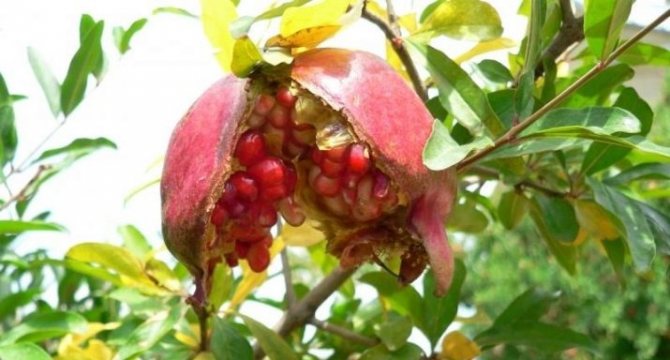

Ahmar
This sort of pomegranate is the pride of Iran. The fruit tree blooms incredibly beautifully! Ripe pomegranates are medium in size with pink-green skin. The grains are pink and, contrary to the usual logic, the lighter the Akhmar grains, the sweeter they are. Another distinctive feature of this fruit is the extremely high amount of sugar in the composition. On this basis, the "Akhmar" fruit is superior to many other fruits.
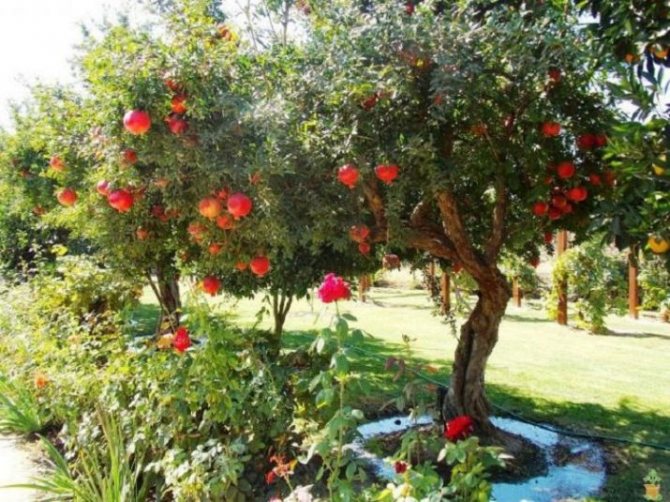

Thuja tish white
If you still believed that the pomegranate must be necessarily red or pink, then this was a delusion. White pomegranate grows in the south of Italy, Egypt and Spain. At first glance, it seems that the fruit is just ripening. But in fact, the grains of the white pomegranate are no less tasty, sweet and healthy than the grains of the traditional varieties of this fruit.
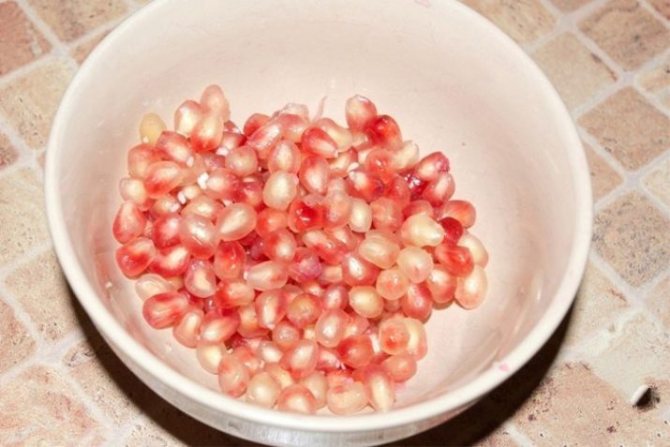

Crimean Ak Dona
Not only abroad, you can enjoy ripe fruit straight from the branch. In the steppe part of the Crimean peninsula, an unusual tree grows, on which weighty oval pomegranate fruits appear. Their skin is quite thin and has a light creamy shade with scarlet specks. The grains have a sweet taste with a pleasant sourness.
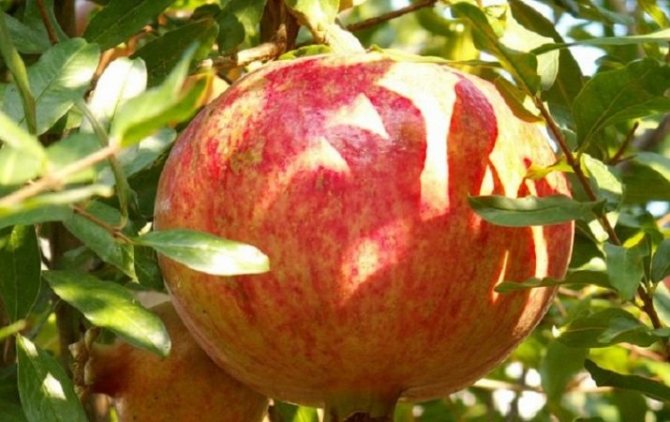

Dholka
This type of exotic fruit grows in India. It is considered to be the sweetest in the whole world. The fruits are small in size and have a dark skin. The grains, on the other hand, are rather light, pale pink. They are used not only as food, but also for medicinal purposes. In particular, a decoction based on this fruit helps fight dysentery. And also to cope with pain from bruises and fractures, to accelerate tissue healing.
But there are also frost-resistant, decorative and indoor shrubs. Many gardeners grow them on their site for beauty, because during flowering, pomegranates are incredibly attractive. And also a variant of an ornamental plant is suitable for cultivation in Siberian regions, where the climate does not allow the crop to ripen.
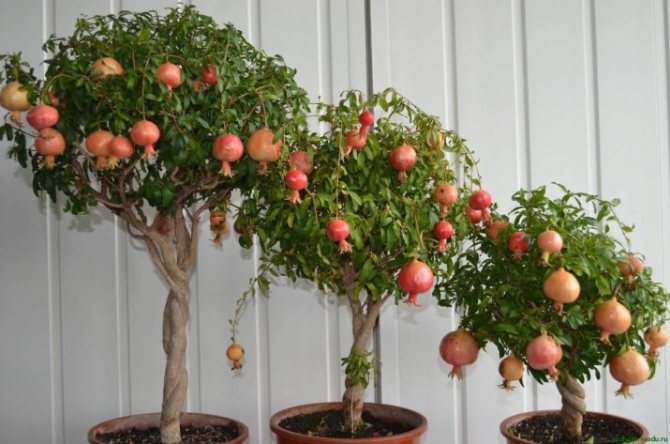

Subtleties of choice
Choosing a truly ripe and tasty pomegranate on the shelves is quite difficult. After all, it cannot be opened and looked at in order to determine the degree of maturity of its seeds. There are some tricks, however, and you need to memorize them before heading to the store to shop. There are several factors to consider when choosing a pomegranate.
Appearance
If the grains of the fruit are fully ripe and filled with tasty juice, then the fruit takes on an angular, square appearance. Perfectly round fruits are almost always unripe, keep this in mind. The degree of ripeness of the fruit also depends on the saturation of the skin tone (but do not forget about the white variety of pomegranate). The petals on the top of a ripe pomegranate should be dry and not firm and green.
The skin of a ripe pomegranate should be smooth and even, without any cracks or dents. And also it shouldn't be too soft.
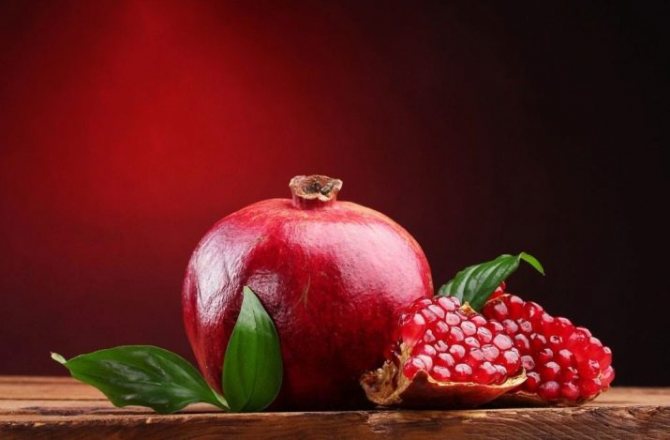

Weight and size
In size, the ripe fruit looks like an orange or an apple. But depending on the variety, there are also larger pomegranates. If you cannot figure out which of two fruits of approximately the same size to choose, take the heavier one. Because it will surely be tastier.
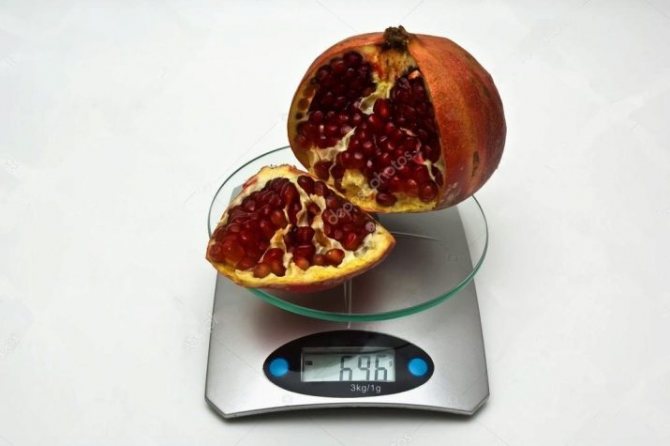

What maturation depends on
The first thing ripening will depend on is when the pomegranate was planted.
- If the seedling is planted in winter, then you can expect fruits only after 2-3 years in the summer.
- If the planting took place in the spring, then the harvest will be closer to autumn, and, most likely, it will be small.
- In the summer, experts advise against planting such plants. If you planted pomegranates in the summer, then in about three years, closer to summer, you can wait for the first fruits.
It should be borne in mind that homemade pomegranates cannot bear a lot of fruit. At the first fruiting, experienced gardeners strongly recommend picking the fruits, since the young tree is not yet ready to ripen a large number of fruits.
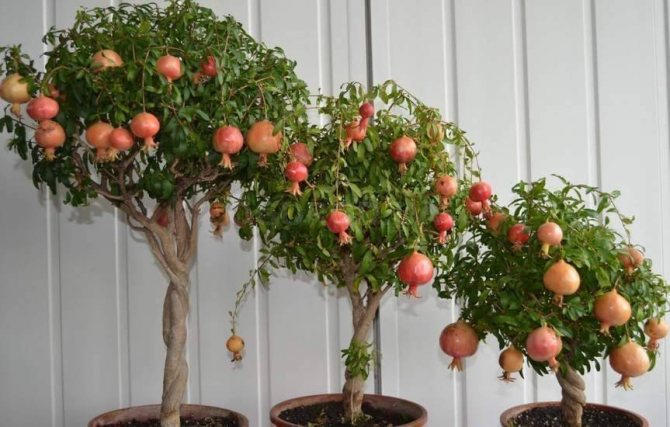

Important to know: homemade pomegranates cannot bear a lot of fruit.
Storage rules
If you buy more than a couple of pomegranates that you are going to eat at one time, then it is important to know the rules for proper storage of the fruit. Otherwise, even the most ripe and delicious fruit will lose its beneficial properties. Let's make a reservation right away that sweet varieties of pomegranate are stored less than sour ones. So, the latter will not deteriorate even after six months of storage in a refrigerator at a temperature of +1 C. And at a temperature of about +10 degrees, the fruits are stored for about 40-60 days.
In order to place fruits that ripen at home, you can use wooden or glass boxes. Place them in a basement, an unglazed loggia, or in the refrigerator. But it is also possible to freeze the grains of the fruit for a long time.
Take note of the listed tips and rules, and you will definitely be able to choose a ripe and tasty fruit!
For information on how to choose a ripe pomegranate, see the next video.
How to choose a ripe pomegranate?
- The pomegranate skin must be free of cracks and defects.
- An unripe pomegranate has a light skin.
- The skin should not be dry, it should be tough and smooth.
- Choose the largest fruit - it has the juiciest grains.
- A ripe fruit is heavier than an unripe pomegranate of the same size.
- When tapped on the skin, a ripe pomegranate produces a metallic sound. If the sound is dull, then the pomegranate is either unripe or overripe.
- If you squeeze the grenade a little with both hands, then you will feel that it is slightly springy. The unripe fruit will be hard.
Pomegranate protects against cancer
Pomegranate juice contains substances that interfere with the synthesis of estrogen and block the growth of malignant neoplasms - ellagitannins. According to a study published in the journal of the American Association for Cancer Research, regular consumption of pomegranate several times reduces the risk of breast cancer.
Scientists are also studying the effects of pomegranate extract on prostate cancer. Due to the high content of antioxidant and anti-inflammatory substances, pomegranate juice slows down the growth of cancer cells. In addition, there is reason to believe that it slows down the development of pulmonary oncology, which makes it possible to more effectively fight the disease.
Pomegranate bracelet salad
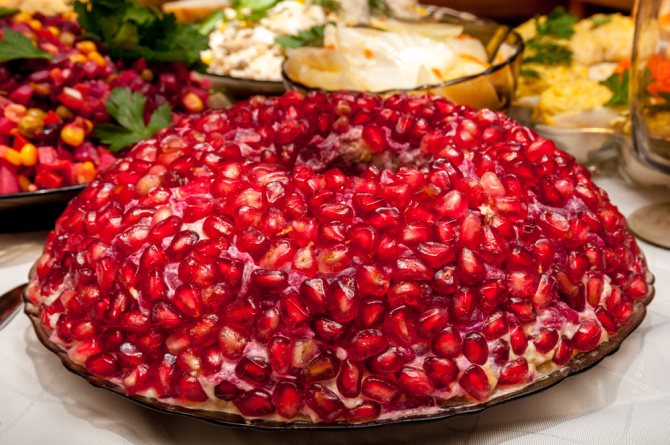

3-4 potatoes potatoes
2 medium beets
400 g chicken fillet
1 white onion
1 pack of mayonnaise
Step 1. Boil potatoes and beets separately from each other and peel.
Step 2. Steam the chicken fillet.
Step 3. Cut the onion into thin rings.
Step 4. Grate warm potatoes on a coarse grater, lay in a thick layer, in a ring. Brush with a thin layer of mayonnaise.
Step 5. Put the chicken on top, sprinkle with scalded onions. Another layer of mayonnaise.
Step 6. Grate warm beets, brush with mayonnaise again.
Step 7. Sprinkle the salad with pomegranate seeds.
Shish kebab in pomegranate marinade
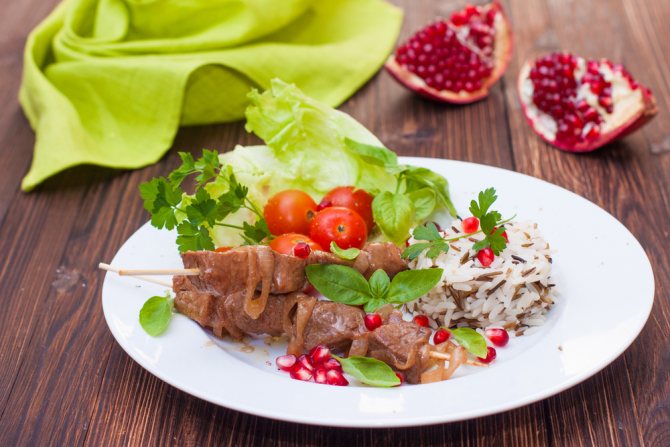

Step 1. Rinse the meat and cut into large pieces. Identical.
Step 2. Peel the onion and cut into thick rings.
Step 3. Squeeze the juice out of the pomegranates.
Step 4. Put the meat and onions in a saucepan, add spices, mix.
Step 5. Pour the pomegranate juice. Press down with a plate, put a load on it.
Step 6. Marinate for 12 hours, then fry over charcoal.
* Caucasian spice mix
Pears in pomegranate syrup
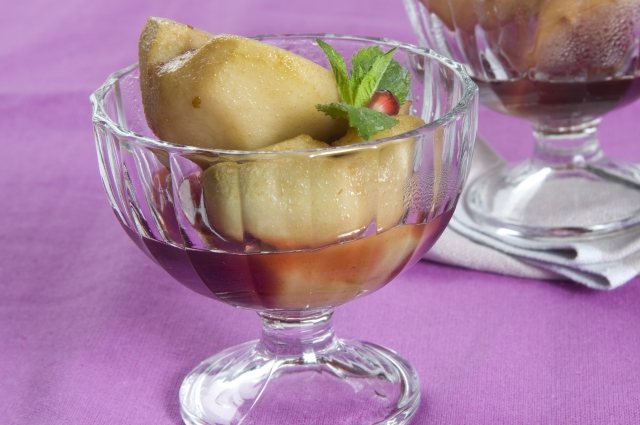

3 cups pomegranate juice
2 tbsp lemon juice
4 carnation buds
1 black peppercorn
A little orange peel
Step 1. Peel the pears, cut in half, remove the seeds and place in a baking dish.
Step 2. For syrup, mix pomegranate juice and sugar, boil to half the volume with a barely noticeable boil.
Step 3. Add lemon juice, cinnamon, cloves, zest, anise and peppercorns, bring to a boil. Add sugar if necessary.
Step 4. Pour this mixture over the pears and bake for 25-30 minutes at 180 ° C, pouring syrup over the pears every 10 minutes.
Step 5. When serving, put the pears in a vase, pour over the syrup. Serve the dessert hot or cold.
Medicinal value
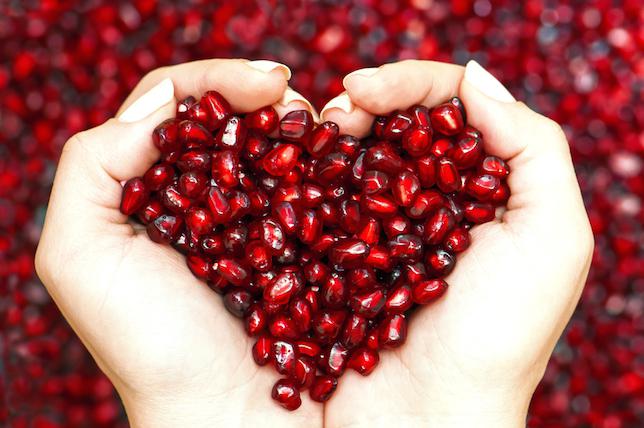

Eastern medicine believes that with the help of red fruits, you can heal from serious ailments. The great scientist Avicenna wrote about this in his treatises. It is not at all surprising why pomegranates are so popular and revered by many peoples of the world. Fruit is a storehouse of health and longevity, it is a real concentrate of vital substances. No part of the fruit should be eliminated.
The peel has excellent cleansing properties. A decoction from it was used to treat dandruff and strengthen the hair. Partitions have a calming effect, relieve nervous strain and insomnia. Bones whet appetite, normalize digestion and restore microflora, as they contain useful plant fiber.
The fruit also helps to eliminate unpleasant clinical symptoms with menopause. It is useful for people with low hemoglobin levels. Pediatricians recommend including it in the diet of weakened children. Cope with pomegranate juice and seeds with anemia, exhaustion and atherosclerosis.
Pomegranate is used for therapeutic purposes for respiratory and dental pathologies. Clinical trials have shown that the extract reduces the occurrence of bacterial infections, diabetes and periodontitis. By rinsing, it is possible to eliminate the unpleasant odor from the oral cavity.
The uniqueness of the berry lies in the fact that it treats diarrhea, gastrointestinal upset, enterocolitis, suppresses dysentery and Escherichia coli.Anti-inflammatory properties are widely used in cosmetology. The juice protects the skin from acne and removes excess oiliness.
The fruits exhibit a whitening effect. It is also noted that pomegranate juice burns fat stores and prevents obesity. The information was obtained in the course of studies on rats suffering from overweight. With daily use after a month, their weight has significantly decreased.
Pomegranate season: the benefits of pomegranate and original recipes with pomegranate from Julia Vysotskaya
Pomegranate is an unusually beautiful and tasty fruit that is admired by aesthetes, gourmets and fans of a healthy lifestyle. In autumn, when the pomegranate season begins, juicy ripe pomegranates from Turkey, Azerbaijan, Armenia, Uzbekistan, Israel, Abkhazia, the Mediterranean and South America appear on the shelves. The pomegranate bears fruit until winter, but due to the fact that it is perfectly stored, you can buy the fruit all year round, enjoying its exquisite taste. However, from a botanical point of view, pomegranate is considered a berry consisting of many small grains hidden under the shell - one pomegranate contains more than a thousand grains! Probably, it is for this reason that ancient healers recognized pomegranate as a symbol of fertility and believed that it cures infertility in both men and women. We have collected interesting facts about the benefits of this "fruit-berry", as well as original recipes with pomegranate from Julia Vysotskaya.
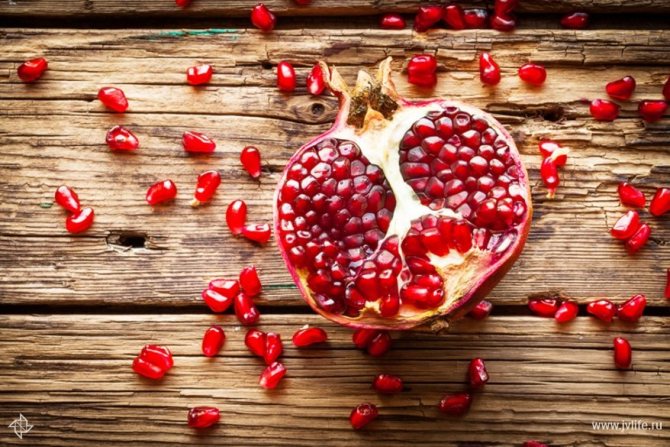

All necessary vitamins, minerals and trace elements are concentrated in pomegranate, so it must be included in the diet.
“The most important property of pomegranate is the ability to raise hemoglobin, normalize blood pressure and lower blood sugar levels by replacing insulin, which is often used by diabetics, who are prohibited from all other fruits. Pomegranate juice disinfects the throat, helping with tonsillitis and acute respiratory infections, and at the same time has antipyretic properties. This fruit is indispensable in case of hormonal imbalance, in case of indigestion and the presence of any inflammatory processes in the organs. In addition, pomegranate removes radioactive substances and toxins from the body. However, due to the high acid content, pomegranate is not recommended for gastritis, as well as for stomach and duodenal ulcers. However, if pomegranate juice is subjected to heat treatment, then even patients with a sick stomach can consume it, albeit in very small doses as part of meals. "
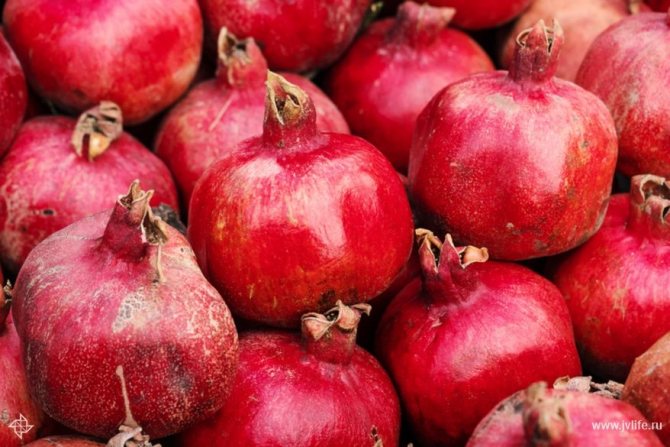

Choosing a pomegranate is not at all a lottery, as many buyers think. There are certain signs by which you can choose a juicy, ripe and sweet pomegranate without buying a pig in a poke. The peel of the pomegranate should be red, sometimes with an orange tint, and if brownish-red spots appear on it, it means that it has begun to deteriorate. Also, there is no damage on the peel of a good pomegranate, and the peel itself should not be dry and wrinkled - this suggests that the pomegranate has been lying for a long time and has lost its juiciness. The skin of a ripe pomegranate is slightly rough, not smooth, since perfect smoothness indicates that the fruit has not yet matured. In an unripe fruit, even the tail will be green.
Ripe pomegranate is always heavy, because all the grains in it are filled with juice, but if the fruit seems too light, then it has begun to dry out. Good quality fruit is usually firm and firm. It is best to buy pomegranates that are brought from nearby countries, for example from Uzbekistan, although Turkish pomegranates, despite the pale and transparent color of the berries, are very sweet.
It would seem that pomegranate is the most difficult fruit in terms of cutting, but Yulia Vysotskaya knows a great way to peel this fruit quickly and beautifully. Cut the pomegranate crosswise into two pieces, take one half of the fruit in your hand, turn it over over the bowl and tap on it with a spoon. All grains will fall out intact into the bowl. Simple and fast!
Ripeness signs
How to distinguish an unripe pomegranate from a ripe one? More often, pomegranates ripen on store shelves, and their appearance can be deceiving. According to some signs, it is possible to determine not only the ripeness of the berries, but even the approximate number of grains. So that the buyer does not have doubts when choosing a ripe pomegranate, he needs to take into account some features:
- The pomegranate seeds should be oblong and ribbed. If they are round, this indicates that they are immature.
- The color of the pomegranate should be bright. Pink and burgundy shades prevail. Pallor - indicates the presence of acid.
- The rind should be whole, dry and thin. The presence of a crack indicates that the berry is overripe.
- A ringing metallic sound should be heard when tapped. An unripe fetus has a dull sound.
- Ripe pomegranate almost does not smell. A strong aroma indicates that the fruit is immature. When the fruits ripen (after 4–5 months), they do not have any smell.
- Ripe pomegranate is elastic. The softness and mottling of the peel results from the decay process.
- Ripe pomegranate is only seemingly light. The weight of the fruit depends on the size of the juicy grains - a heavy fruit is definitely juicy, and an unripe one is light.
- The maturity of the pomegranate can be determined by the inflorescence (ovary). The flower should be dry, ripe, without any greenery.
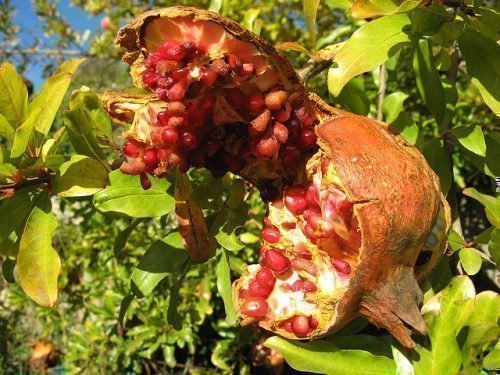

Overripe Grenade Burst
Pomegranate in cooking


Juicy pomegranate seeds have a pleasant sweet and sour taste with light astringent and tart notes. For this reason, pomegranate is used as a spicy addition to various dishes, and in the East it is added to hot sauces and marinades to enrich the taste. The whole world is famous for narsharab sauce, which is boiled pomegranate juice.
Pomegranate is used to prepare flaky salads, its exquisite sourness is ideally combined with meat, fish, vegetables and legumes. Many Asian chefs marinate meat in pomegranate juice, making it unusually soft and juicy, and pomegranate juice is also added to meat and fish when stewing. Barbecue recipes with lamb pomegranate or pilaf with pomegranate are recognized classics of Caucasian cuisine. Compotes, jelly are made with pomegranate, it is added to desserts and baked goods, and the Indians dry the fruit of the pomegranate and use it as aromatic spices. Dried and crushed pomegranate crusts are part of the Caucasian seasoning "bakharat"; pomegranate seeds are used to decorate dishes. And in the Caucasus, these fruits are used to make jam, marshmallow, jam, make tinctures and wine.
Chemical composition [edit | edit code]
The pomegranate fruit consists of juice (38.6–63.5%), peel (27.6–51.6%) and seeds (7.2–22.2%). In the best cultivated varieties of pomegranate, the edible part is 65-68%, and the juice yield is 78.5-84.5%.
The energy value of 100 g of the edible part of the pomegranate fruit is 62-79 kcal, and 100 ml of juice is 42-65 kcal. The fruits of the plant contain about 1.6% protein, 0.1-0.7% fat, 0.2-5.2% fiber and 0.5-0.7% ash.
The juice and pulp of seeds of ripe fruits of cultivated varieties of pomegranate contains up to 20% sugar, from 0.2 to 9% organic acids, including citric 5-6%, and a small amount of malic acid. Pomegranate juice contains 0.208-0.218% of minerals, including manganese, phosphorus, magnesium, aluminum, silicon, chromium, nickel, calcium, copper. The content of vitamins (mg%): C - 4.0-8.7; B1 - 0.04-0.36; B2 - 0.01-0.27; B6 - 0.50; B12 - 0.54; many P-vitamin-like substances, niacin, traces of vitamin A and folacin. The juice of wild varieties of pomegranate contains 5-12% sugar, and acidic acids - more than 10%. Tannins and dyes in pomegranate juice 0.82-1.13%, flavonoids, including anthocyanins, 34.0-76.5%.
In addition to phenolic compounds, pomegranate juice contains 15.5-29.2 mg% catechins, about 2% proteins, 61-95 mg% amino acids (of which 15 amino acids have been identified: cystine, lysine, histidine, arginine, aspartic acid, serine, threonine , glutamic acid, alanine, hydroxyproline, alpha-aminobutyric acid), 6-20% fatty oil, consisting of linoleic (40.03%), palmitic (16.46%), oleic (23.75%), linolenic (2 , 98%), stearic (6.78%), begonic (1.63%) acids. In addition, 3.4% nitrogenous substances, 12.6% starch, 22.4% cellulose. Pomegranate oil contains 272 mg% vitamin E.
"Garnet Bracelet": a classic of modern cuisine
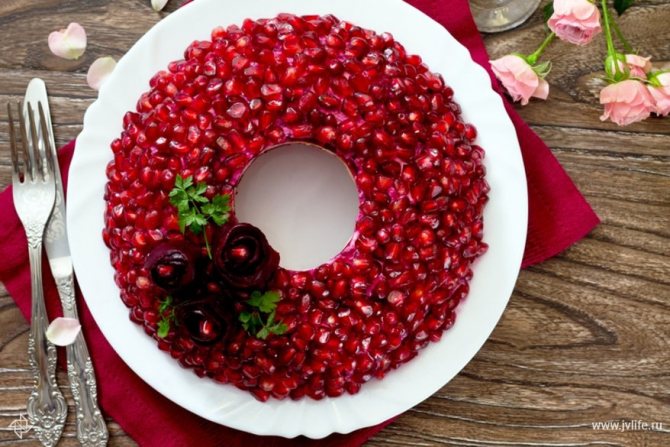

Would you like a recipe for a delicious salad with pomegranate from the Eat at Home website? Try to cook "Pomegranate Bracelet" - a very original, bright and unusual dish that will decorate the festive table and cheer everyone up!
Boil 3 carrots, 3 potatoes and 3 beets in the peel, cool them, peel and grate on a coarse grater, and mix one third of the beets with half a glass of walnuts, chopped in a mortar. Boil 2 chicken breasts or 2 legs with bay leaves, after cooling, remove the peel and chop the meat into cubes. Grate 3 boiled eggs on a coarse grater, finely chop a medium onion and simmer until soft in water with a small piece of butter.
food with the chef
Autumn is the season of pomegranates. The chef of the Nabi restaurant Pavel Petukhov tells about what they are, how they are useful for health and how they can be used in the kitchen.
- Is pomegranate a fruit or a berry?
- Berry. Pomegranate shrubs bloom with red, white or pink flowers, and then berries are formed from the ovaries - the familiar fruits in a dense leathery skin the size of a large apple. Under the skin are numerous seeds, each of which is surrounded by a ruby, juicy, sweet and sour pulp.
- Does the pomegranate have its own season?
- Well, we can talk about the pomegranate season from Central Asia and the Caucasus - it lasts from the end of September to the end of November. And throughout the year, of course, imported pomegranates are available - from South America and Africa. In principle, they do not differ in taste - it is just that pomegranates are cheaper in the fall. In general, pomegranate is one of the oldest cultivated plants. They began to cultivate it, in all likelihood, in Persia or Afghanistan. Nowadays, many varieties have been bred; in our time, these fruits are grown almost all over the world. In Europe, Italy, Portugal and Iceland. Eastern peoples, as in antiquity, consider pomegranate a symbol of wealth, abundance and fertility, they call it “the king of all fruits”. There is even an opinion that the tail of the pomegranate became the prototype of the royal crown.
- Are there only red grenades?
- Fruits can differ in shades and color saturation - pomegranates can be bright red and more faded, pink. The main thing is that the color of the peel is even, and the texture is dense, thin and dry - this means that the fruit is fully ripe. The taste, by the way, also, depending on the variety, varies from sour to sweet. Inside, a ripe pomegranate has beautiful, even, delicious grains separated by the thinnest film.
- Is pomegranate eaten only fresh?
- Most often, yes. At least, there are few dishes prepared specifically from pomegranate. But to eat fresh pomegranate, frankly, is rather difficult and inconvenient - there are a lot of seed-seeds inside. There is a legend that there are exactly 365 pomegranates in a pomegranate - the same number, as many days a year. But in fact there are more than a thousand of them. By the way, bones are also quite edible. The Chinese, for example, believe that pomegranate seeds, ground together with sugar, are very useful for men.
- And yet it is much easier to squeeze the juice.
- Yes it's true. But there is one way to make it easier to clean the pomegranate. To easily get the seeds, you need to cut off the top of the pomegranate, cut the peel and soak in a bowl of cold water. Then, holding the fruit under water, gently break it - the grains themselves will fall to the bottom. Throw away everything except the grains and dry them by draining the water.
- Are there any secrets for squeezing juice?
- Pomegranate juice can be obtained in the same way as orange juice - cut the fruit in half and squeeze the juice out of the halves using a citrus juicer. Or you can simply knead the seeds in a sieve with a spoon. Usually it is juice that is used for food. If the pomegranate itself lies in a cool, dry place at room temperature for a month and a half, then pomegranate juice in jars can be stored much longer, and you can drink it throughout the winter.Due to vitamins A, C and E, iron and organic acids, it is very useful for the human body - it has a beneficial effect on the stomach, kidneys, increases hemoglobin, and strengthens the heart. Drinking pomegranate juice is recommended before meals - it improves appetite and promotes good digestion. If you sterilize pomegranate juice and add sugar to it, you get grenadine - an indispensable ingredient for many cocktails. Many different sauces are prepared on the basis of pomegranate juice.
- Yes, this is one of the most popular sauces in the Caucasus. Cooking it is as easy as shelling pears, you just need to evaporate the pomegranate juice - over low heat for an hour. And serve - with fish, meat or poultry, you decide. Pomegranate juice is also added to marinades when marinating beef or lamb, it gives dishes a very delicate sourish tint. Pomegranate goes especially well with game - pomegranate jams or chutneys can be used as a side dish. And in India, for example, pomegranate is used as a seasoning - its dry crushed seeds are added to vegetables and beans. In combination with slightly hot pepper, such a seasoning gives a specific sweet and sour, astringent taste.
- What kind of dessert can you make with pomegranate?
- For example, jelly with pomegranate. Squeeze juice from three pomegranates. Dissolve gelatin in warm water, mix half with milk and refrigerate for half an hour. Transfer the remaining gelatin into a container with pomegranate juice, mix. Pour milk jelly on top, refrigerate again for 30-40 minutes. For decoration, you can use pear, pear peel, chocolate chips. And you can make it even easier - mix pomegranate seeds with ice cream, heavy cream and crushed meringue. Serve with tea brewed on dried pomegranate flowers - the tea turns out to be red, pleasantly sour in taste and resembles tea made from hibiscus flowers.
Scientific facts
Is pomegranate a fruit or a berry? Many people are interested in this question. The answer is obvious - a berry, just like a watermelon. Its properties and composition have been well studied by experts from many countries. In the course of research, scientists have found that seeds are rich in antioxidant substances. The fruit is considered the best natural cure for malignant tumors, it prevents the formation of free radicals.
American and British doctors have confirmed the presence of anti-inflammatory properties. Natural extract from the peel helps to protect the cartilage from destruction. It strengthens the immune system and makes the body resistant to staphylococcal and viral infections.
The fruit is a good help for people whose activities are associated with active mental stress. It activates brain function and improves memory, and at the same time strengthens nerve cells and helps to resist stress. This is explained by the presence of vitamin B1.
Sweet seeds contain a lot of ascorbic acid, vitamins B6, C, E, A, PP. The fruit is rich in numerous trace elements, minerals, natural organic acids, tannins and essential amino acids. No wonder it is called with the elixir of youth, beauty and good health.
Vegetable garden and stuff
Pomegranate is a southern plant, it loves warmth and ripens in warm regions by the middle of autumn, if not later. Today, there are also frost-resistant and early ripening varieties, but growing pomegranates in the middle lane in the open field is an activity for extreme people.
Pomegranate is a southern plant, it loves warmth and ripens in warm regions by the middle of autumn, if not later. Today, there are also frost-resistant and early ripening varieties, but growing pomegranates in the middle lane in the open field is an activity for extreme lovers.
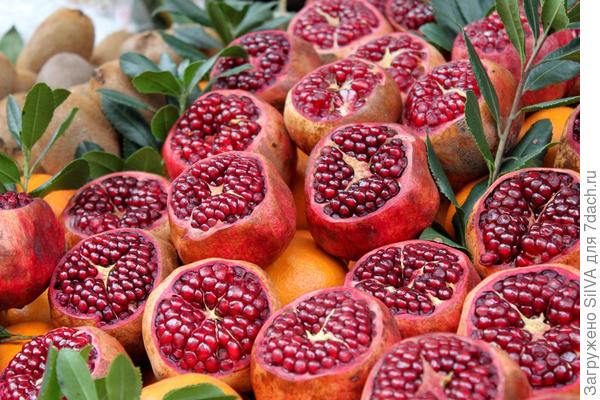

Depending on the variety and type of pomegranate, as well as the region in which it was grown, the berries can be sour or sweet. Sweet taste usually have pomegranates grown in Turkmenistan, Azerbaijan near the Talysh mountains and Nachikhevan, Central Asia. Sour taste Karabakh and Ganjavin, West Azerbaijani grenades. Georgian can also be recognized by their sour taste and pink flesh with white, slightly pinkish grains.
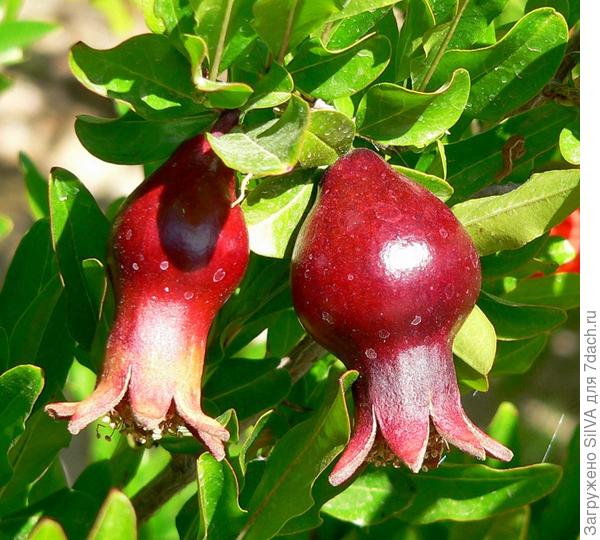

Pomegranate (Punica) belongs to the family Derbennikovye... These are shrubs or small trees up to 6 m in height. Pomegranate belongs to deciduous crops. Its branches are thin and have thorns on them. The pomegranate has 2 main types of flowers: those that form an ovary (in the form of a jug), and those that do not form fruit (in the form of a bell). Sterile flowers can also be distinguished by their small size, short pistil. Such flowers fall off quickly. There is also an intermediate form of flowers. The color of the flowers is orange-red.
Why pomegranate does not bear fruit
The pomegranate tree does not ripen and does not bear fruit for natural reasons and if the rules of care are not followed, due to poor climatic conditions.
Natural Causes - Since the pomegranate is a cross-pollinated plant, fruiting depends on the structure of the flower:
- inflorescences with a short pistil are not pollinated and fruits are not tied;
- flowers with an elongated pistil form an ovary.
Fruiting on a pomegranate tree may not occur for unnatural reasons. These include:
- Cold weather - Pomegranate ripens only in regions with warm climates.
- Lack of light, the tree must be grown in a well-lit area. In the shade, flowering will be scarce or absent altogether.
- Depleted soil, the berry ripens only on fertile, loose soil with neutral acidity.
- The pomegranate ripens and bears fruit only on the grafted tree.
- The pomegranate tree does not like frequent watering. On moistened soil, it will begin to hurt, the flowers will begin to fall off and the fruits will not be tied.
Reproduction of pomegranate
Pomegranate multiplies cuttings (vegetative method) and seeds.
Seed method - take the seeds from a fresh, well-ripened fruit, you do not need to peel. Spread the seeds over the surface of the moistened soil, sprinkling the soil with a layer of about 1.5 cm. While the seeds are germinating, the soil should not be allowed to dry out. When the seeds germinate and reach a height of 3 cm, they are dived or transplanted so that the distance between the shoots is at least 4 cm. When the seedlings grow so much that there are no gaps between the shoots, they are dived again.
Cuttings - cuttings are cut from annual woody shoots of young plants. The size of the cutting is about 25 cm. For these purposes, you can also use the shoots. For rooting of the cuttings, well-fertilized and drained areas are used. The cutting should be rooted in a soil warmed up to 12 ° C to a depth of about 10 cm. In this case, 1 internode should remain above the soil surface. Green twigs take root in late May - early June.
Plant care during fruit ripening
In order for the pomegranate to bear fruit well and give a high-quality harvest, it is necessary to properly care for it:
- Watering... The tree must be moistened at the root so that the liquid does not penetrate the leaves. For these purposes, use a watering can with a narrow spout.
The soil should always be slightly damp. It is necessary to use water at room temperature and settled for irrigation. - Top dressing... Since the fruits will be eaten, it is better to use for fertilizers not mineral compositions that contain nitrates, but organic ones - slurry, a solution of chicken droppings.
Collection and storage of the harvest of pomegranates
In the south of Russia (some regions of the Kuban) and in the Crimea, fruits begin to be harvested in October. They have reached their maximum maturity, the grains are full of sugars, and the rind takes on a rich red or yellow-pinkish speckled color.
Fully ripe pomegranates can crack, for storage you need to guess with the time of collection up to this point.
The pomegranate has excellent storage properties and retains its freshness for a long time. The fruits cannot be stored at subzero temperatures, otherwise they can rot. A ventilated room with an air temperature of +2 ° C will be optimal.

